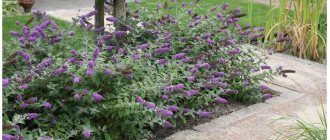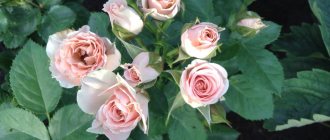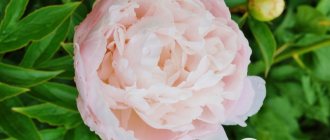0 8143
Russian gardeners increasingly began to plant wrinkled-looking roses on their plots. This phenomenon can be explained by the unpretentiousness of care and ease of planting of this plant. It is classified as a member of the rose hips and rose family. Miniature flowers are famous for their aroma with sweet notes, and the fruits for their beneficial properties. However, it is quite difficult to find this copy on the market.
Peculiarities
The advantage of this plant is its attractive appearance and original structure. This allows you to organize a unique flower garden that will attract admiring glances. It is also called rose rugosa or wrinkled rose. The natural habitat is considered to be Japan, the Far East, China and Korea.
If we talk about the benefits of this flower, we cannot miss the fact that it can easily tolerate low temperatures and drought. However, if it happens that more water is poured on it than necessary, the plant will also be able to survive this. The flowering period is long, which adds another plus to it.
The specimen can be used as an independent flower, as well as in combination with other representatives of the flora. The wrinkled rose looks good as a “living fence”, as well as decorating roadsides and other various areas.
When talking about the structure of a plant, it is important to emphasize its dimensions. It is capable of spreading over a fairly large area, while being a powerful specimen. The height can reach two and a half meters. On erect shoots there are reddish thorns-needles of various sizes. The green leaves have a wrinkled coating, and the underside is colored with gray-green colors and slightly covered with hairs. Typically the leaf blade grows to twenty-two centimeters.
The color scheme of the buds is so different that it is difficult to list all the colors. However, they range from pink and white to rich red tones. As a rule, flowers are located singly on a bush, but sometimes they occur as a group of eight pieces. The bud can reach different sizes - 6-12 centimeters, and the texture can be both regular and terry. All these indicators vary depending on the varieties.
The flowering period usually begins from the last days of May - the first days of June. The fruits usually appear simultaneously. Their color changes depending on the degree of ripening. Thus, in the summer they are colored with orange tones, and by autumn the color changes to burgundy or lemon. The relatively large, fleshy fruits can be used for treatment and in cooking. In one season, the amount of fruit collected can reach 3-4 kilograms. The root system is located quite deep underground - 2-2.5 meters and expands over a large area, more than a meter. Thanks to these properties, this plant can be planted to strengthen the soil on slopes and ravines.
Flower breeding
Like any garden rose, rugosa and its hybrids are propagated by cuttings. For procreation, strong stems with several buds are chosen. Propagation of flowers is also possible with seeds. They are collected from ripe fruits. The grains remain viable for several years. Each gardener chooses for himself a convenient method of growing these flowers.
Varieties and description
The best known varieties are those that contain the Grotendorst surname in their name. This surname belonged to a Dutch gardener who managed to develop a large number of new species of wrinkled roses. However, there are also other varieties that have unique characteristics.
Queen of the North
Its advantages include resistance to frost, fungi and infections. It also grows and develops quite quickly. The height can reach two meters, and in areas with a cold climate - about a meter. The flowering period is quite long - all summer and early autumn. Large double buds are colored deep pink, and sometimes white-pink. Its fruits are used to create tinctures, jams and compotes.
Rubra
The 2.5-meter rose rugosa rubra is decorated with large pink flowers in summer. Subject to favorable weather and various positive factors, flower buds can bloom again during the season. At the end of summer, orange fruits appear. The plant is valued due to its unpretentiousness and easy care. It can be used to decorate mixborders and hedges.
Grootendorst
In 1978, another hybrid was developed. Its flowers are arranged in groups of up to 10 pieces on one brush. A raspberry bud can reach 4 centimeters in diameter. Its shape resembles a carnation. For this reason, the plant may also sometimes be called carnation rose.
Pink Grootendorst
The difference from the previous variety is the color of the buds - it is pink. The height of the bush is one and a half meters. It is covered with wrinkled leaves of light green shades with a shiny coating and during the flowering period is decorated with 3-centimeter buds. Thanks to its lush flowering, the shrub looks presentable and can be used to decorate mixborders, hedges, or simply organize group plantings.
Abelzieds
The 2.5-meter shrub is a variety of the Rubra variety. Cup-shaped pinkish flowers can reach 5-6 centimeters in diameter. The flowering is lush, but the aroma is weak.
Alba
White buds are located densely on the bush, but have practically no smell. The plant is valued for its resistance to frost. Even in Siberia, the rugosa alba rose will feel good. It can be used to decorate flower beds, hedges and other flower arrangements of various types.
Hansa
The appearance resembles the Alba variety, but the color of the buds is different - pale pink. Goes well with low-growing plants.
My Hammerberg
This variety is the shortest of all wrinkled roses - about 50 centimeters. Large leaves are painted bright green, and 9-centimeter flowers are purple. The variety has a list of positive properties. For example, the aroma is quite strong, frost resistance is high, and it does not need to be covered for the winter.
General information
This variety of rose is a shrub plant, reaching several meters in height. The branches of the bush come in various shapes; they can spread above the ground or rise above the soil. Obsolete shoots, over time, begin to lose foliage and acquire a brown tint.
Wrinkled rosehip has lush foliage, which in its texture resembles a “reaper”. By the end of autumn, the leaves turn bright yellow.
Rubra is one of the first plants to bloom, beginning or mid-June. By the beginning of autumn, large orange fruits begin to ripen on the rose.
The homeland of this rose is considered to be the East (China, Eastern Siberia), where it grows mainly on the coast, which is why it is often called a “coastal flower.”
The plant is not whimsical, so it tolerates changes in high temperatures. In addition, the bush can be planted in fresh or salty soils. Several other varieties of this plant were bred from it, the flowering properties and strong aroma were preserved.
Many inexperienced gardeners do not know that wrinkled rose and wrinkled rose hip are the same thing, only in all countries it has a different name.
How to choose seedlings
If a gardener decides to use a purchased seedling, then its acquisition should be taken very seriously. Therefore, the following points need to be taken into account:
- The shoot must have a smooth surface with no damage;
- It is best to use annual specimens;
- When purchasing in a store, you must take into account the fact that due to long-term storage in the package in winter, the root system of the seedling may become too dry. Therefore, it is necessary to clarify the storage period and conditions;
- It is better to avoid specimens with buds that have already bloomed. Such a moment may prevent the seedling from adapting to a new territory;
- For the full development of the root system, the seedling must be transported with exposed roots. But it is important to ensure that they do not dry out. To avoid this problem, it is recommended to wrap them with a damp cloth or place them in a bag of water or damp soil.
Beneficial features
Preparations made from the fruits of rose hips rugosa have various pharmacological activities due to the presence of a complex of vitamins and bioflavonoids.
Their main beneficial properties:
- antisclerotic;
- hepatoprotective;
- hypoglycemic;
- anti-inflammatory;
- diuretic;
- regenerating;
- choleretic.
More information about the composition and beneficial properties of the plant’s berries can be found here.
Landing
The optimal time for planting is spring. But in warm climates, the procedure can be performed in the fall. It is best to choose a site for growing that is level and has sufficient sunlight. The south side would be a suitable solution. The soil should be saturated with humus. Loamy soil would be a good option. If extremely poor soil is available, then it is recommended to add organic matter to the planting holes. Before you start planting a seedling, you need to place the roots in a clay mash and fill the hole with humus (1 bucket).
When planning a wrinkled rose, it is necessary to maintain 1.5 meters from each other and other plants. And when creating a hedge, the distance is reduced to a meter. Under no circumstances should you fill up the growth point of a bush - the plant may die. The depth of the hole into which the specimen is transplanted must correspond to the previous one. When the bushes are planted, they should be watered generously, sprinkled with dry soil and compacted. To increase the likelihood of flower adaptation, it is recommended to soak the root system in water to which growth stimulating agents are added for several hours.
Rosa rugosa rugosa is difficult to withstand the wind. Therefore, it is best to plant it near a fence or buildings. When creating a mixborder, it is better to place it in such a way that the shadow of taller trees covers it. The most optimal temperature for successful development is considered to be 16-22 degrees Celsius. But even such a short-term frosty temperature as 40 degrees below zero, the shrub can survive. Young species are recommended to be covered at night when autumn-winter begins, using film or insulating material. This procedure should also be carried out with adult specimens throughout the winter period if they grow in a northern climate.
The soil moisture level should be moderate. If it is increased, then the risk of developing fungal and infectious diseases also increases. Therefore, when it rains, it is better to cover the bushes with film, and when it ends, refrain from watering for 7 days.
But during the hot summer, it is necessary to water the shrub when the top 5 centimeters of the soil dries out. It must be sprayed generously in the morning and evening. During the day, when the sun is already shining brightly, it is better to refrain from such a procedure, because the reflection of rays from drops of water can cause burns on the leaves.
Rules for propagating wrinkled roses
There are three main methods for propagating wrinkled roses:
1) Using seeds. This is not a very effective method because the desired characteristics of the plant may be lost.
2) Using root shoots. To do this, they dig up offspring that have grown thirty to forty centimeters. The rhizome is trimmed using a shovel. You don’t have to do this procedure, but simply form adventitious roots by hilling the area. You also need to add a certain amount of humus and pour plenty of water. A year later in the fall, you can trim the roots of the bush, which grows along with the stems, leaving fifteen centimeters.
3) Using cuttings. Young cuttings are harvested in early June. They need to be cut from the bush along with 3 nodes. Be sure to remove any foliage from the bottom. To ensure that the cuttings take root well, treat them with Heteroausin. Before planting, add fertilizer to the soil. Cuttings need to be planted to a depth of ten to fifteen centimeters. There should be at least one and a half meters between the plants themselves. Then water the soil thoroughly and cover with film. Leave one third of the total length of the plant.
Care
- Watering. During watering, water should not get on the leaf blades and flowers. During the active growth phase, the procedure is carried out twice a week. One bush needs 12 liters of liquid.
- Feeding. Organic fertilizers should be applied twice each season. Humus and mullein are used in autumn and spring. When the growing season begins, you need to add magnesium and iron. To improve immunity and longer flowering, it is recommended to use fertilizers with a broad composition.
- Mulching, loosening. During the first 3 years of life, you should carefully loosen the soil around the plant. Mulching helps fight weeds and maintains the desired level of soil moisture.
- Trimming. A couple of years after planting in April, it is necessary to free the rose from dry, diseased branches. This must be done before new shoots appear. Hedges are pruned every year.
- Transfer. A rose can grow without changing its place for 20 years. It should be replanted if an infection appears or the flowering rate has dropped. This operation must be carried out after the development of the fruit. The plant must be cut at the root, removed from the soil with an earthen lump and transferred to a new trench. Then liquid organic matter is used and a shelter is organized for the winter.
Pests
Mole crickets have appeared in the garden, this is very dangerous for your flowers, find out how to get rid of the pest
Medvedka
Several sources of foamy liquid have been observed on the rose bush; this is a dangerous pest.
Slobbering Penny
At 5 years old, no more than 20 strong shoots are left on the rose. All shoots that have reached 7 years must be removed. The fruits of the Rugosa rosehip can be eaten, dried for brewing as a drink, or made into medicinal infusions.
Fruit harvesting should be carried out from August to October. The first frosts take away the beneficial properties of the fruits, so there is no point in collecting them after frost. Rugosa Rubra is a thorny plant, so it is necessary to handle it and collect the fruits only with pilot, rubberized gloves.
Application in landscape design
A white rose can be combined with coniferous representatives of the flora, placing it in the foreground. It is also used to decorate borders. The climbing type is used for landscaping the walls of buildings, arches, and fences. The ground cover type looks good with spreading evergreen bushes, as well as chrysanthemums, peonies, and irises.
Growing in the garden
In the garden, wrinkled rose hips are propagated in several ways: by seeds, suckers, dividing the bush and cuttings.
Planting shrubs is recommended in the fall - in October or in the first ten days of November. Further care includes several activities:
- Fertilizer application - nitrogen compounds are used for this purpose. They are introduced for the first time in the third year from the moment of planting. Fertilizing is carried out at the beginning of the growing season, as well as before and after flowering.
- Pruning is carried out regularly to eliminate old, diseased and weakened shoots.
- Preparation for winter involves covering the tree trunk before the onset of severe frosts. For this purpose, use fallen leaves, straw, compost or peat.
- Disease and pest control - shrubs are treated with insecticides and fungicides. Affected branches are cut off and burned.
What it is?
Wrinkled roses (Rugosa, wrinkled rose hips) are a species of the Rosehip genus from the Rosaceae family, an ornamental shrub plant. It has several garden varieties, is easy to care for and is widespread in temperate climates. Capable of forming impenetrable dense thickets.
The plant is a bush with straight thick stems from 1 to 2.5 m in height . Young stems are thin and elastic, green, old ones are thick, woody, red-brown.
The shoots are covered with small thin thorns, against the background of which thick, sharp thorns on a wide base stand out (which varieties of roses do not have thorns?). The roots reach 3 m in length, white-brown, highly branched.
The leaves have the shape of an elongated ellipse and jagged edges, wrinkled, bright green, reach a length of 2.5 to 5 cm, and are covered with short white hairs. The flowers are white, red or pink, and have a delicate fruity aroma (read about the variety of rose colors here). The fruits are up to 2-3 cm, round and flattened, fleshy, and as they ripen they change color from green to red.











